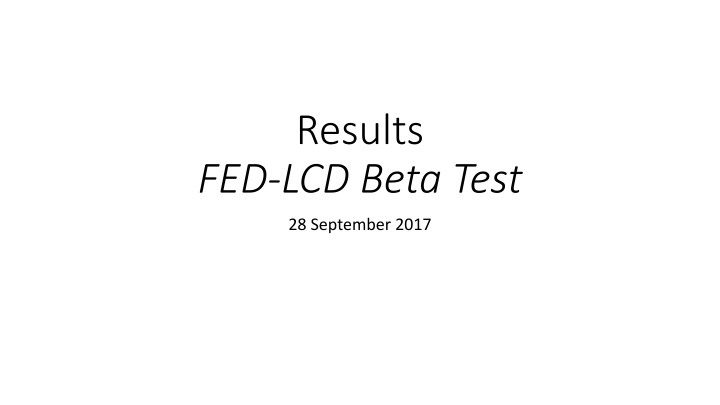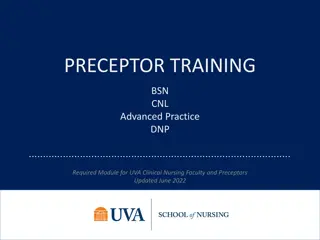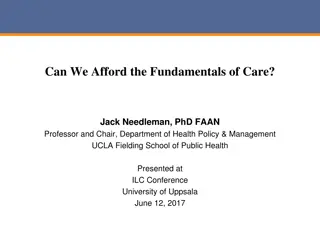Challenges and Solutions in Determining Nursing Facility Clinical Eligibility
Challenges identified in the subjective nature of Current Level of Care Determination (LCD) and its impact on the judgment of Nursing Facility Clinical Eligibility (NFCE). This analysis reflects discrepancies in disability domains and NFCE determination, suggesting the need for a more standardized approach. The transition to Functional Eligibility Determination (FED) with the use of the InterRAI-Home Care tool in Pennsylvania aims to address these issues effectively.
Uploaded on Feb 27, 2025 | 0 Views
Download Presentation

Please find below an Image/Link to download the presentation.
The content on the website is provided AS IS for your information and personal use only. It may not be sold, licensed, or shared on other websites without obtaining consent from the author.If you encounter any issues during the download, it is possible that the publisher has removed the file from their server.
You are allowed to download the files provided on this website for personal or commercial use, subject to the condition that they are used lawfully. All files are the property of their respective owners.
The content on the website is provided AS IS for your information and personal use only. It may not be sold, licensed, or shared on other websites without obtaining consent from the author.
E N D
Presentation Transcript
Results FED-LCD Beta Test 28 September 2017
Current Level of Care Determination (LCD) Is subjective and may leave judgment of nursing facility clinical eligibility (NFCE) to the assessor Problems Length (takes as much as 90 min to complete) Non-standardization (assessors can skip across sections) Contains detailed cognitive assessment but not required and often not completed Unrealistic for assessors to attribute disability to specific physiologic systems or medical conditions Review of 80,000 LCDs (2013-16) suggest mismatch between cardinal disability domains and NFCE determination 15% of consumers without any help across five key domains used to define NFCE (ADL, toileting, cognition, mobility, eating) were nonetheless considered NFCE Some consumers with disability in these areas were not designated NFCE
Functional Eligibility Determination (FED) With transition to Medicaid Managed Long Term Care Services (MLTSS) in PA, care management needs in NFCE consumers will be assessed with the InterRAI-Home Care (HC), a broadly used, standardized tool. The PA Office of Long Term Living (OLTL) considered eligibility determination using a similar approach appropriate FED developed in 2016-17, reviewed by community stakeholders, and approved by OLTL FED assesses five cardinal NFCE domains (ADL, toileting, cognition, mobility, eating) using InterRAI-HC questions, probes, and scoring. Reports of need for help in the domains are aggregated using an automated computer algorithm to assign NFCE or nursing facility ineligible (NFI) status
FED Beta Test (May-July 2017)-1 Compare FED and LCD ratings of disability in the five domains and NFCE/NFI status assigned by assessors (LCD) or by algorithm (FED) in the same set of consumers. Ten AAAs/counties completed separate FED and LCD ratings with consumers on the same day. Different assessors from the same agencies conducted each assessment to prevent contamination in ratings. FED assessors completed 1-day in-person training with InterRAI staff after reviewing on-line and printed training materials. Consumers were contacted in advance and agreed to dual assessments.
FED Beta Test (May-July 2017)-2 Counties were selected to cover rural-urban differences across the state and variation in the size of agencies and consumer populations. Aimed for a total of 200 consumers split evenly between <age 60 and 60+. In fact, the counties completed 168 consumer assessments with 1/3 < age 60. Seven of the 10 counties completed the full complement of 20 assessments. Linked de-identified LCD and FED forms were sent to the University of Pittsburgh, where data were cleaned and entered. When necessary, the research team contacted local sites to clarify missing values or incomplete forms.
% (n) County Allegheny 11.9 (20) Blair 11.9 (20) Erie 11.9 (20) Huntington-Bedford-Fulton 11.9 (20) Montgomery 11.9 (20) Perry 6.5 (11) Philadelphia 11.9 (20) Snyder-Union 3.6 (6) Warren 11.9 (20) Wayne 6.5 (11) Total 100.0 (168)
% (n) 63.7 (107) Female 31.5 (53) < Age 60 98.8 (166) English speaker 83.9 (141) White Residential Status Private home/apartment/room Long term care facility/nursing home Acute care hospital Board and Care home Other (jail, group home, psych, rehab) 61.3 (103) 28.6 (48) 4.8 (8) 2.4 (4) 2.9 (5) Living Arrangement: Lives with Non-relatives Alone Spouse/partner Adult child Spouse/partner/others Other relatives Parent 31.5 (53) 27.4 (46) 15.5 (26) 8.9 (15) 6.5 (11) 5.4 (9) 4.8 (8)
LCD NFCE % (n) Sample % (n) FED Level ADL Toilet Eating Mobility Cognition 7.5 (12) 100.0 ----- 32.5 (52) 29.4 (47) 0.6 (1) 1.9 (3) 11.3 (18) 12.5 (20) 1.3 (2) ----- 3.1 (5) 1 2 3 4 5 6 7 8 9 10 11 Full Full Full Full Full Full Full ----- 92.3 66.0 100.0 66.7 55.6 45.0 0.0 ----- 20.0 Full Full, or Full, or Full Partial Partial Partial Partial support in any 3 domains Partial support in any 2 domains Partial support in 1 domain Partial Full Partial No disability Note: n=160 had an LCD assessor NFCE determination
Comparing LCD and FED NFCE defined as FED levels 1-6 achieved highest sensitivity (82.5%) and specificity (54.3%), kappa = .37, relative to LCD assessor NFCE determination
FED Diagnostics Relative to LCD Assessor NFCE Determination as Gold Standard FED NFCE, % LCD NFCE % Sample Sensitivity, % Specificity, % Kappa Total 72.6 (n=167) 71.3 (n=159) 82.5 54.3 .37 Age <60 77.4 (n=53) 75.5 (n=49) 78.4 33.3 .12 Age 60+ 71.1 (n=114) 69.1 (n=110) 82.9 64.7 .48
Total agreement, % Specificity Sensitivity Elimination 65.0 71.7 52.6 Eating 61.1 36.2 95.6 Mobility 77.8 98.2 34.6 Cognition ---- ----- ----- ADL 86.6 86.8 85.7 NFCE (FED 1-6) 74.4 82.5 54.3
Conclusions FED is practical and feasible in the real world setting of NFCE determination. It can be completed in 20 min. With very little missing data. FED is effective for eliciting cognitive status, which is a challenge in the LCD. The FED identifies disability more effectively than LCD and is highly concordant with LCD for more severe levels of disability. Comparing FED and LCD suggests a cutoff at disability level 6 for NFCE determination. Extending NFCE to FED disability levels 7 and 8 would also be reasonable given that nearly half of these consumers were considered NFCE by LCD assessors.
Limitations In an ideal world, we would conduct an independent study Would require use of an independent geriatric specialist as the gold standard, or perhaps a longitudinal cohort to determine risk of nursing home admission by FED disability level and LCD NFCE determination We can show that the FED corresponds reasonably well with the LCD and offers a number of advantages in administration and standardization, as well as consistency in NFCE























